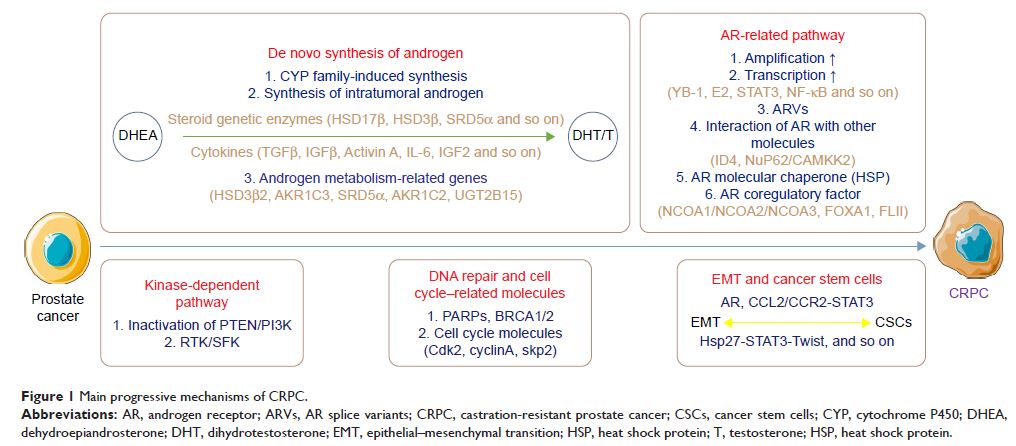108985
论文已发表
注册即可获取德孚的最新动态
IF 收录期刊
- 3.4 Breast Cancer (Dove Med Press)
- 3.2 Clin Epidemiol
- 2.6 Cancer Manag Res
- 2.9 Infect Drug Resist
- 3.7 Clin Interv Aging
- 5.1 Drug Des Dev Ther
- 3.1 Int J Chronic Obstr
- 6.6 Int J Nanomed
- 2.6 Int J Women's Health
- 2.9 Neuropsych Dis Treat
- 2.8 OncoTargets Ther
- 2.0 Patient Prefer Adher
- 2.2 Ther Clin Risk Manag
- 2.5 J Pain Res
- 3.0 Diabet Metab Synd Ob
- 3.2 Psychol Res Behav Ma
- 3.4 Nat Sci Sleep
- 1.8 Pharmgenomics Pers Med
- 2.0 Risk Manag Healthc Policy
- 4.1 J Inflamm Res
- 2.0 Int J Gen Med
- 3.4 J Hepatocell Carcinoma
- 3.0 J Asthma Allergy
- 2.2 Clin Cosmet Investig Dermatol
- 2.4 J Multidiscip Healthc

去势抵抗性前列腺癌进展机制和治疗的最新进展
Authors Wang K, Ruan H, Xu T, Liu L, Liu D, Yang H, Zhang X, Chen K
Received 13 December 2017
Accepted for publication 1 April 2018
Published 28 May 2018 Volume 2018:11 Pages 3167—3178
DOI https://doi.org/10.2147/OTT.S159777
Checked for plagiarism Yes
Review by Single-blind
Peer reviewers approved by Dr Andrew Yee
Peer reviewer comments 2
Editor who approved publication: Dr Jianmin Xu
Background: Although there have been great advances in mechanisms and
therapeutic methods of prostate cancer, the mortality rate of prostate cancer
remains high. The castration-resistant prostate cancer (CRPC), which develops
from hormone-sensitive prostate cancer, foreshadows a more dismal outcome.
Concomitant with the researches in the mechanism of CRPC and therapy for CRPC,
more and more landmark progress has been made in recent years.
Methods: A number of clinical and experimental studies were reviewed to
indicate the novel advancement in the progressive mechanism and therapy of
CRPC.
Results: The androgen receptor (AR ) is still a
vital driver in the progression of CRPC, while other multiple mechanisms also
contribute to this progression, such as tumor immunity, cancer stem cells,
epithelial–mesenchymal transition and DNA repair disorder. In terms of the
therapeutic methods of CRPC, chemotherapy with drugs, such as docetaxel, has
been the first-line therapy for CRPC for many years. Besides, newer agents,
which target some of the above mechanisms, show additional overall survival
benefits for CRPC patients. These therapies include drugs targeting the
androgen axis pathway (androgen synthesis, androgen receptor splice variants,
coactivators of AR and so on), PI3K-AKT pathway, WNT pathway, DNA repair,
rearrangement of ETS gene,
novel chemotherapy and immunotherapy, bone metastasis therapy and so on.
Understanding these novel findings on the mechanisms of CRPC and the latest
potential CRPC therapies will direct us for further exploration of CRPC.
Conclusion: Through comprehensive consideration, the predominant mechanism of
CRPC might be the AR signal axis concomitant with tumor microenvironment,
stress, immunity, tumor microenvironment and so on. For CRPC therapy, targeting
the AR axis pathway and chemotherapy are the first-line treatments at present.
However, with the advancements in CRPC therapy made by the researchers, other
novel potential methods will occupy more and more important position in the
treatment of CRPC, especially the therapies targeting the tumor
microenviroment, tumor immunity and DNA repair and so on.
Keywords: CRPC, androgen receptor, tumor immunity, mechanism, therapy
